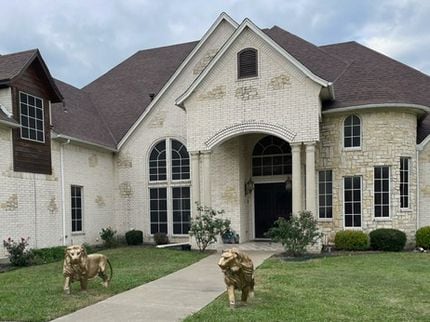One of the comforts of homeownership is having a literal roof over your head, and an attractive roof can enhance the beauty of your home. But lower quality materials or extreme weather can significantly shorten your roof’s lifespan. We asked two local experts for tips to help your rooftop last longer and the best course of action to prevent damage.
Related:Home inspectors want you to check your property for these 8 issues
Materials matter
Most North Texas homes feature architectural asphalt shingles, says Jarrod Alexander, aka the “Shingle Sheriff,” of Absolute Construction, which has provided roofing services for customers in Garland and Plano since 2004. These shingles are considered Class II in terms of impact resistance from hail or flying debris, based on the UL 2218 resilience test performed by Underwriters Laboratories (UL). Lower-quality Class I three-tab shingles, typically preferred by homebuilders, are being phased out, Alexander notes, but even Class II shingles generally last only 15 years under typical weather conditions in the Dallas area.
Impact-resistant shingles are rated Class I – IV based on the degree of impact they’re able to withstand as determined by the UL 2218 impact test. The Highlander architectural shingles installed by Absolute Construction have a Class III rating.(Courtesy Absolute Construction)
Some roofers also offer lifetime composite shingles, which match the look of traditional shingles and are rated Class IV, the highest UL 2218 durability rating. Asphalt shingles with this rating should not show signs of breakage, cracks or excessive granule loss in the wake of a major hailstorm. Although Class IV composite shingles are about 30% more expensive than traditional asphalt options, many insurance carriers offer a discount of 10% to 27% on the premium for a homeowner’s policy when you choose these materials, notes Ernest Arnesen, owner of Energy Roofing Solutions. If you are planning to move in a few years, the investment may not make sense, he says, but if you stay in your home longer term, the savings can add up.
For those wanting a designer option that’s also durable, he recommends terra cotta barrel tiles, stone-coated shingles or slate shingles. Rated Class III or IV, these materials fall on the higher end of the spectrum for both resilience and price, and may require a specific lathing system to support the weight of the shingles. Synthetic slate shingles are a more affordable alternative and come in a variety of colors that can enhance a home’s exterior. However, the labor can be pricier because the installation process is more involved, says Arnesen, whose company installs quality roofs for residential and commercial buildings throughout the Dallas metroplex.
Metal roofs — available as either shingles or sheets — are also popular for higher-end homes and can last up to 100 years, but, as Arnesen notes, they can become dimpled by a bad hailstorm and lose their aesthetic appeal.
Get updates from Abode
/cloudfront-us-east-1.images.arcpublishing.com/dmn/BLYJVUD42VHQHIEJI4PP4AFLBI.JPG)
Protecting your investment
Once you have a roof in place, you want to make it last. This can be tricky in North Texas, where extreme high temperatures, hailstorms and high winds all take a toll on rooftops. Although insurance carriers generally cover the repair or replacement of a roof damaged by storms, nobody wants to risk water getting into their house or deal with the hassle of filing a claim and having contractors at their home for several days. In addition to investing in more durable roofing materials, our experts recommend a few simple measures to prolong the life of the roof on your house.
For homes with standard composite shingles, proper attic ventilation is key to improving a roof’s longevity, notes Arnesen. When the attic gets too hot, it starts to bake the shingles, which in time can get brittle and hard. “It doesn’t take a very severe hailstorm to cause damage when the shingles are compromised,” Arnesen says.
/cloudfront-us-east-1.images.arcpublishing.com/dmn/TGRUQO3Z7VHR5BITYS6VGLEG3Y.jpg) Jarrod Alexander of Absolute Construction advises homeowners to troubleshoot potential damage before signs are visible by getting regular inspections. Preventative maintenance, such as keeping the roof and gutters clear of leaves and debris and replacing loose shingles, can also help homeowners avoid headaches later.(Getty Images)
Jarrod Alexander of Absolute Construction advises homeowners to troubleshoot potential damage before signs are visible by getting regular inspections. Preventative maintenance, such as keeping the roof and gutters clear of leaves and debris and replacing loose shingles, can also help homeowners avoid headaches later.(Getty Images)
You should also check your attic vents after a rainstorm to ensure they aren’t allowing water to seep in and soak the interior of your roof. If leaking is a problem, consider switching to vents that have guards designed to keep water out, even in heavy winds.
Lastly, troubleshoot potential damage before signs are visible by getting regular inspections, advises Alexander. “I would have your roof inspected every two to three years, regardless of storms,” he says. Preventative maintenance, such as keeping the roof and gutters clear of leaves and debris and replacing loose shingles, can also help homeowners avoid headaches later.
Older homes may be more susceptible to roof problems, as well, since foundation issues can cause the roof to shift and create valleys or loosen the flashing around chimneys and vents. Those valleys are particularly attractive to squirrels, which can cause a lot of damage by chewing through roof decking and peeling off shingles.
Ultimately, whether you need only minor repairs or are replacing your roof outright, knowledge is power, says Alexander. “Hire professionals and do your research on roofing companies,” he says, adding, “You get what you pay for, and a roof is very important to your overall well-being.”
www.dallasnews.com
https://www.dallasnews.com/abode/2024/01/19/north-texas-roofing-pros-weigh-in-on-the-best-types-of-roofs-and-how-to-make-them-last/














